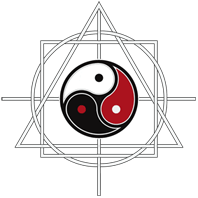
The First Personality Reading Based On
The Sacred Geometry Of Your Name Symbols.


The circle evolves into the Vesica Piscis by adding a second circle of the same radius.
The circle represents unity and completeness, a perfect form that refers to individuality. As it evolves towards the Vesica Piscis, the shape opens up to accommodate an area of sharing, the fruit of the meeting of two circles, symbolizing the union of two individuals. This transition shows a need to find the right balance in the relationship, to maintain a certain distance to avoid total fusion, while creating a meaningful space for connection.
The circle evolves into the diameter by dividing the circle into two equal parts.
The circle, symbolizing wholeness and unity, becomes a diameter by being cut in two, representing polarization and duality. This passage marks a division that introduces a separation between the conscious and the unconscious, initiating differentiation within unity, by division.

The Vesica Piscis, representing the fusion of dualities, evolves into a triangle by connecting the points of intersection of the circles.
The Vesica Piscis evolves into the triquetra by adding a third circle of the same radius, representing the reconciliation of opposites in a triple unity.
The cross is created by adding a perpendicular to the diameter.
The diameter symbolizes the link between two points, illustrating a simple duality. As we move towards the 4-pointed cross, this duality expands to create a space structured in four directions.
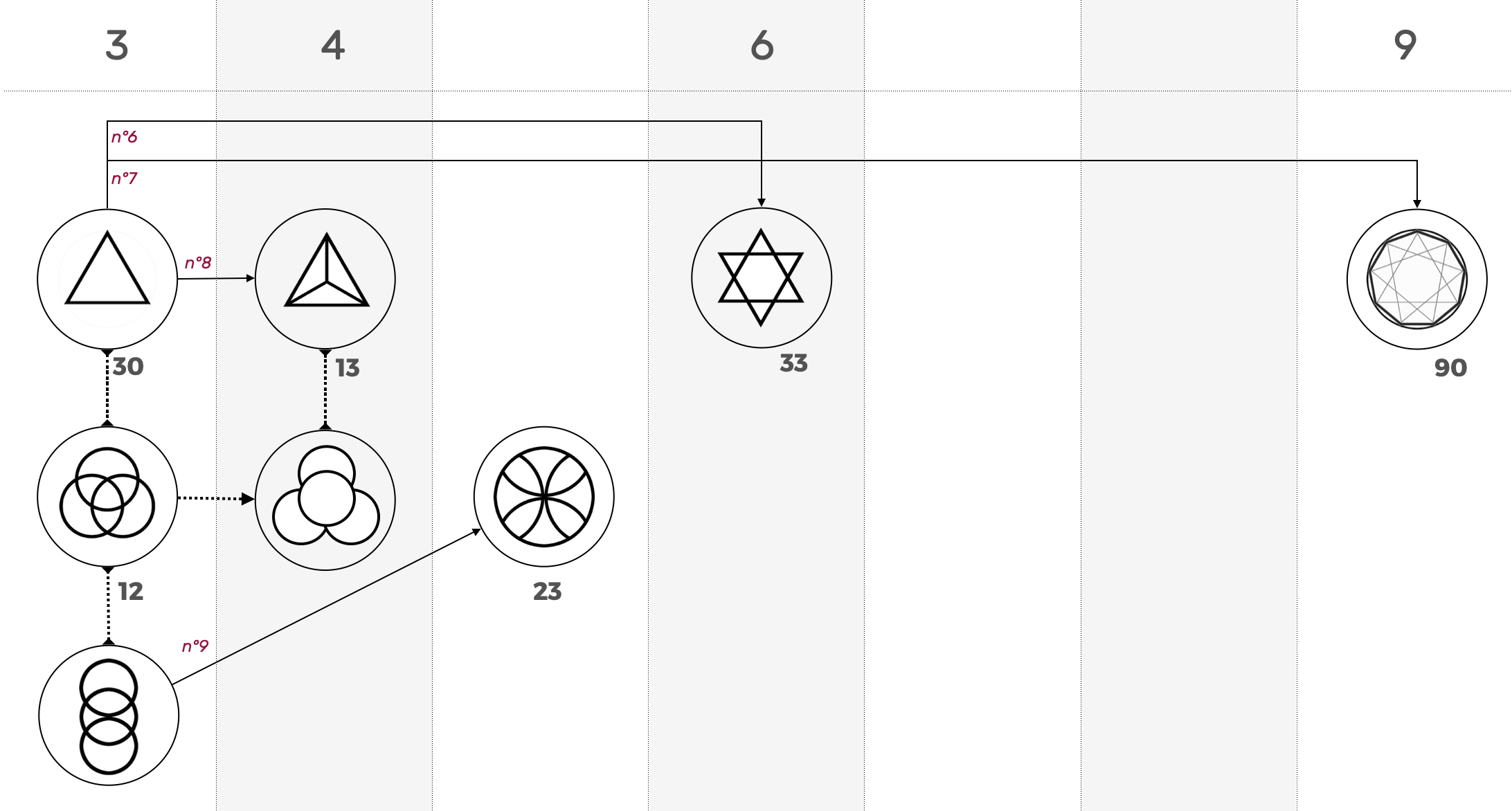
By duplicating and rotating the initial triangle by 180°.
The triangle, representing intellectual thought, is transformed into a hexagram by duplication and rotation, forming a six-pointed star. This transformation shows a harmonious fusion of spiritual and intellectual energies, creating a structure of wholeness and balance.
Structural identity between triangle and triquetra
Only the unit of measurement changes. The point for the triangle and the circle for the triquetra.
The enneagram is created by duplicating the basic triangle twice and rotating it by 40°.
This complex nine-pointed figure marks an expansion and proliferation of mental energies, reflecting a desire for intellectual development and a multiplicity of perspectives, but also suggesting a tendency to dispersion.
By solidifying the triangle.
The triangle, representing intellectual momentum, evolves into a tetrahedron, forming a three-dimensional structure. This transformation marks a densification of mental energy into a solid form, symbolizing an elevation towards the intellect.
Structural identity between the triquetra and the three worlds (vertical).
Only the arrangement of the three elements changes.
By adding a horizontal temporal axis.
The triquetra represents the union of the three vertical elements: spirit, soul and body. By integrating a horizontal dimension, the Templar cross adds a temporal dimension, symbolized by two additional circles. This transformation introduces a mastery of inner/outer exchanges, fostering an energy of integration that enables us to open up to others while maintaining a strong inner anchorage.

Integration of the three basic movements of sacred geometry: diplication, rotation and homothety.
The tetrahedron, symbol of intellectual solidity and spiritual strength, is transformed into a triangulation by the addition of triangles to its faces. This transformation shows an expansion of mental understanding towards wider connections, marking an opening towards multiplicity of perspectives and in-depth exploration.
From the 3D tetrahedron to the 4D hypertetrahedron. The pentagram is a flat view of a 4D object.
The tetrahedron is a three-dimensional figure representing solid stability and clear structure in physical space. By evolving towards the pentagram, the individual is invited to broaden his or her field of perception, moving to a higher dimension (from 3D to 4D). The pentagram thus becomes a two-dimensional representation of a more complex reality, marking a desire to go beyond the limits of the material world and explore deeper planes of consciousness.
By adding four circles to the four ends of the Cross.
The 4-pointed cross extends to the four cardinal points, symbolizing outward openness. The Templar cross reintroduces a return to the center, forming a circle around each end. This transformation shows a balance between inside and outside, where the individual is anchored in the present moment, drawing on the surrounding energy for nourishment while redistributing this energy harmoniously.
Structural identity of the tetrahedron
Constructed either with points or spheres.
From plane to volume.
The 4-pointed cross, representing a fundamental balance, is transformed into a 6-pointed cross by the addition of a further axis. This evolution symbolizes an extension of stability in more directions, marking an opening to new dimensions of being.
Drawing the square by linking the four ends of the cross, forming a stable structure. This transition suggests a consolidation of energies, moving from an open form to a closed structure.
The square, symbolizing material stability, evolves into a pyramid by adding a vertex, representing an elevation towards the intellect. This transformation marks a shift from matter to spirit, suggesting a need to transcend the material base to reach higher levels of understanding.
By duplicating and rotating the square at 45°.
The static square is transformed into a dynamic octagram by duplication and rotation, illustrating the setting in motion of material generation. This transition from passive to active square evokes an energy of manifestation, where pragmatic ideas (4) materialize into concrete results (8). The octagram reflects an expansion of material forces and the power of concretization.

The hexagram is a flat view of a 5D object.
The pentagram, with its five branches, symbolizes the dimension of the soul and human aspirations. As it evolves into the hexagram, the figure gains further symmetry, illustrating a structure of unity and wholeness. However, these figures are projected shadows of multidimensional shapes (a 4D tetrahedron for the pentagram and a 5D tetrahedron for the hexagram), underlining their illusory nature.
The Templar cross is a 2D vision of the Seed of Life.
The Templar Cross, while not part of the Flower of Life, shares an affinity with the Seed of Life, marking a transition from 2D to 3D. By adding a third axis, the Templar cross takes on additional depth and space. This transformation symbolizes a broadening towards an integrative perspective, unifying inner and outer dimensions in a movement of expansion.
By adding an inverted pyramid.
The pyramid, representing intellectual elevation and personal development, evolves into an octahedron by adding an inverted pyramid. The octahedron embodies three-dimensional balance and added depth, where intellectual ascent is accompanied by introspective descent, symbolizing a harmonization of material, emotional and intellectual dimensions.
Integration of the three basic movements of sacred geometry: diplication, rotation and homothety.
The pyramid, marking an impetus towards intellectual elevation, transforms into a quadrature by adding an enlarged base, thus creating a stable, anchored structure. The quadrature symbolizes material achievement and the perfect balance between spiritual elevation and physical foundation.

The hexagram, symbolizing the harmonization of opposites, becomes a centered hexagram by adding a focal point. This transformation marks a concentration of spiritual energy around a center, symbolizing a deep inner anchorage in the harmonious structure.
The hexagon, symbol of emotional balance, becomes the emotional triangle when its structure is imprisoned in a triangle. This configuration shows a confinement of the emotions within a rigid intellectual form, marking a conflict between the mental and the emotional. The triangle controls and restricts the hexagon, preventing free expression of feelings and reminding us of the need to refocus.
By linking the hexagon's vertices to the figure's center.
The hexagon, symbolizing emotional harmony, is transformed into a centered hexagon by adding a center. This center introduces a point of internal stability, reinforcing the structure and marking a quintessence of emotional balance. The centered hexagon thus becomes a symbol of wholeness and integration of emotional energies.
Connecting the points of the star to the center of the figure.
The 6-pointed cross, representing the balance of will, evolves into a hexagon by closing the branches to create a harmonious space. The hexagon, with its six equal sides, becomes a symbol of natural balance and emotional harmony, marking the consolidation of the structure into a complete form.
Transition from 3D to 4D.
The 6-pointed cross, representing will, develops into an 8-pointed cross. The addition of a new axis represents a shift in dimension, from will to realization. This evolution indicates an extension of the capacity for action, moving from a simple inner alignment to a broader projection into the world.
Connecting the points of the star to the center of the figure.
The octahedron, symbolizing the dynamic balance between top and bottom, is transformed into a cube by a stabilization and densification of the form. The cube, as a perfect, stable three-dimensional form, marks a total anchorage in material reality. This evolution represents the passage from a harmonious, ethereal form to a solid, immobile structure, signifying complete rootedness in the physical world and matter.
According to Carl Jung, each person not only has their own unique unconscious mind, but also shares some elements of unconsciousness with all other people. He called this shared unconscious, the collective unconscious.
Jung suggested that there are archetypes (images and memories of important human experiences) that are passed down from generation to generation. These archetypes can be common designs, shapes, colors, and figures seen over and over again throughout time.

By adding a diameter to the Centered Hexagram.
The Centered Hexagram, symbol of spiritual light and harmony, evolves into the Star of Destiny with the addition of a horizontal diameter. This diameter embodies a desire to expand knowledge and bring light to as many people as possible. This transformation represents a shift from internal balance to external radiance, marked by horizontal mental and spiritual expansion.
By agglomeration and solidification.
The seed of life represents a luminous potential, an energy in full expansion. As it evolves into the egg of life, this light densifies and takes shape, marking a transition from light (7) to matter (8). The egg of life, with its interlocking spheres, embodies a phase of consolidation and solidification, where energy is transformed into a stable material core.
The cube and the egg of life are structurally identical.
Only the unit of measurement changes. The point for the triangle and the sphere for the egg of life.
By adding a unit.
The centered hexagon, representing emotional stability, becomes a cube by solidification into a three-dimensional structure. This transformation marks densification and material anchorage, a state where energy is ready to take shape in the physical world.

Connecting the ends of the cross.
The 8-pointed cross symbolizes expansive, material energy, projected in all directions. When it transforms into an octagon, its branches are linked to form a closed space, marking a passage towards a stabilized form. The octagon is often seen as a sign of rebirth, a state where energy condenses and integrates into a harmonious structure. It is also associated with the squaring of the circle, embodying the union of the spiritual and the material to create a perfect balance between the two.
Connecting the octagon's vertices to the figure's center.
The octagon evolves into a centered octagram through concentration, becoming a material quintessence. The center added to the figure intensifies its stability and transforms diffuse energy into harmonized power, embodying a form of material completeness and mastery.
Both have eight units in the periphery.
Same as n°30. Duplicate with n°16
By linking the octagram's vertices to the figure's center.
The octagram, representing material and energetic abundance, evolves into the centered octagram through concentration, becoming a material quintessence. The center added to the figure intensifies its stability, transforming diffuse energy into harmonized power, embodying a form of material completeness and mastery.


Crosses symbolize primary forces not yet embodied in a specific form. They represent balance and potentiality, the directions or meeting points of forces. These lines provide an initial structure for future forms.
Crosses serve as a basic grid on which geometric shapes can be built. They symbolize the alignment and interconnection of forces prior to their materialization. Their radiant energy is expanding.
Psychology: Crosses symbolize decision points or choices to be made. They represent the idea that the individual is confronted with opposing or divergent forces that need to be aligned. These forces are not yet embodied, but exist in potential. Psychologically, this corresponds to a moment when the person is at a crossroads, with multiple possible directions.
Role: The cross evokes awareness of oppositions, dualities or internal tensions that the individual must resolve before progressing. These are the psychic grids that will structure the first mental and emotional patterns.

Simple polygons like the square are basic geometric shapes that emerge from crosses. They represent the first stages of manifestation. Each polygon is a closed shape that gives structure to space.
Simple polygons bring the first materialization of ideas or forces, forming basic figures in the archetypal world. Their formative energy is also expanding.
Psychology: Simple polygons (triangle, square) represent the stage when the individual begins to give definite form to his thoughts and emotions. This is the first phase of mental structuring. For example, the triangle could symbolize the structuring of logical thought, while the square represents the idea of security or material stability.
At this stage, the individual is building a solid psychic foundation. They begin to understand the world through simple structures, facilitating the organization of experiences.
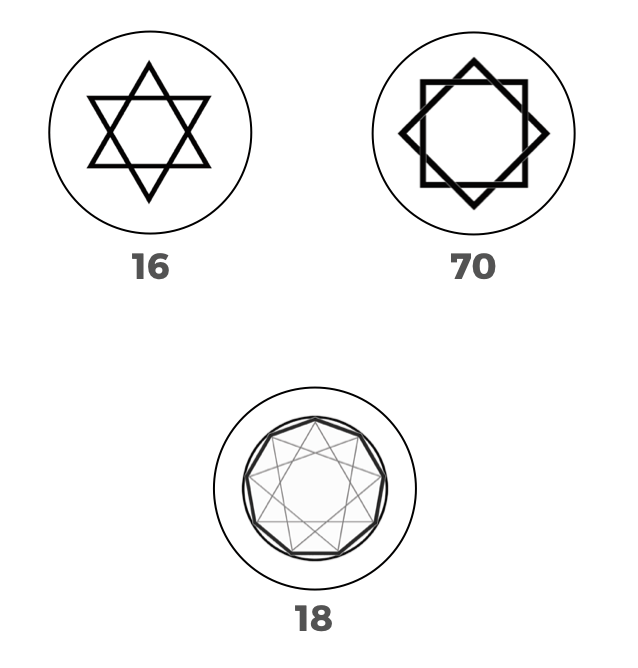
Double and triple polygons are more complex versions of single polygons. They represent the idea that basic shapes can repeat, interact or overlap, creating more complex interactions between forces.
These polygons represent transformation, the ability of simple forces to interact to form richer structures, evoking more elaborate levels of existence.
Psychology: Double/triple polygons (like the Star of David) represent increased complexity in the psyche. The individual begins to see how his or her thoughts and emotions interact in more complex, sometimes conflicting, but often enriching ways. This corresponds to the development of awareness of multiple experiences and perspectives.
Role: At this stage, the individual begins to manage the diversity of influences in his or her life and mind. They integrate ideas and emotions that may appear to be in opposition, but in fact coexist within the same psychic dynamic.

Centered polygons introduce the idea of a center of balance. Around this center, shapes structure themselves harmoniously, generating stability. These shapes indicate that the initial forces have been organized around a central axis, acting by concentration.
Centered polygons create a balance between internal and external forces, harmonizing the chaos and complexity of double/triple polygons to bring coherent order. Their energy is in attraction/concentration.
Psychology: Centered polygons (like centered hexagons) represent a moment of inner balance. There's a psychic center beginning to assert itself, a point of stability around which all experiences gravitate. This symbolizes the building of a strong ego, a psychic center capable of handling life's complexities without being overwhelmed.
Role: Psychologically, this is the stage when the individual begins to balance thoughts and emotions, to build an axis of internal stability. The center symbolizes the conscious ego, which becomes a stable reference for navigating through challenges.
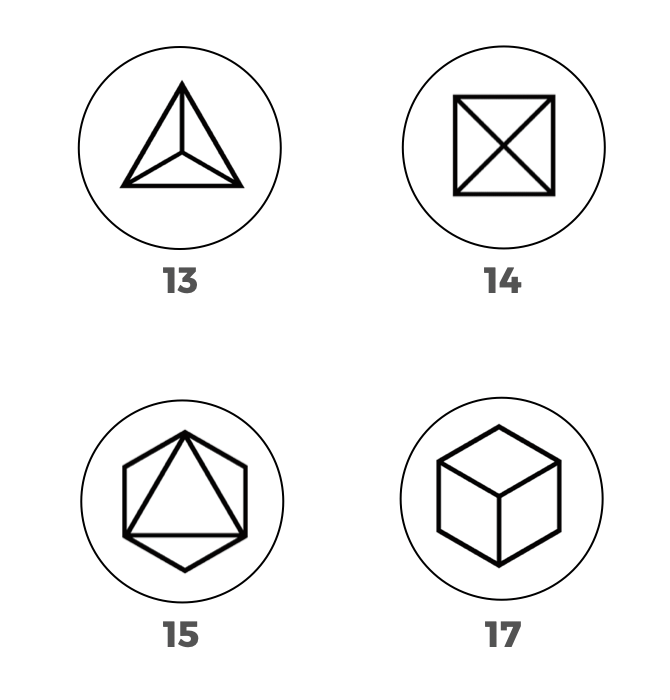
Solids are the three-dimensional shapes that emerge from polygons. They fully embody the idea of densification in the physical world. These solids, like the cube or the tetrahedron, are stable constructions in three-dimensional space.
Solids represent total stability in the material world. They are the culmination of the geometric idea, moving from flat (2D) to three-dimensional (3D) form. Their energy is also in attraction, but in densification, solidification.
Psychology: Solids (tetrahedron, cube) represent anchorage in concrete reality. Psychologically, this corresponds to an individual who is beginning to fully integrate his emotional and mental experiences into the reality of everyday life. There's a three-dimensional aspect, indicating a psychic stability that enables the individual to adapt to the outside world while remaining connected to his inner core.
Role: This is the stage of psychological maturity, when the individual is able to translate his thoughts and emotions into concrete action in the material world, while remaining true to himself.

Mixed symbols combine different geometries and elements. They show how different forms from different levels of existence interact and coexist. They are hybrid structures, often more complex.
They symbolize the Transmutation of different forms and dimensions. These symbols illustrate how distinct forces or concepts can unite to create complex realities.
Psychology: Mixed symbols represent the psychological complexity of the individual as a multidimensional being. This could correspond to an individual who integrates different facets of his psyche (his rational, emotional, material and spiritual sides). He is capable of navigating complex situations, where he must call upon several aspects of himself.
Role: This is the integrated awareness of all dimensions of being. Psychologically, the individual recognizes that his or her identity is made up of different parts that can coexist harmoniously, even if they sometimes seem contradictory.
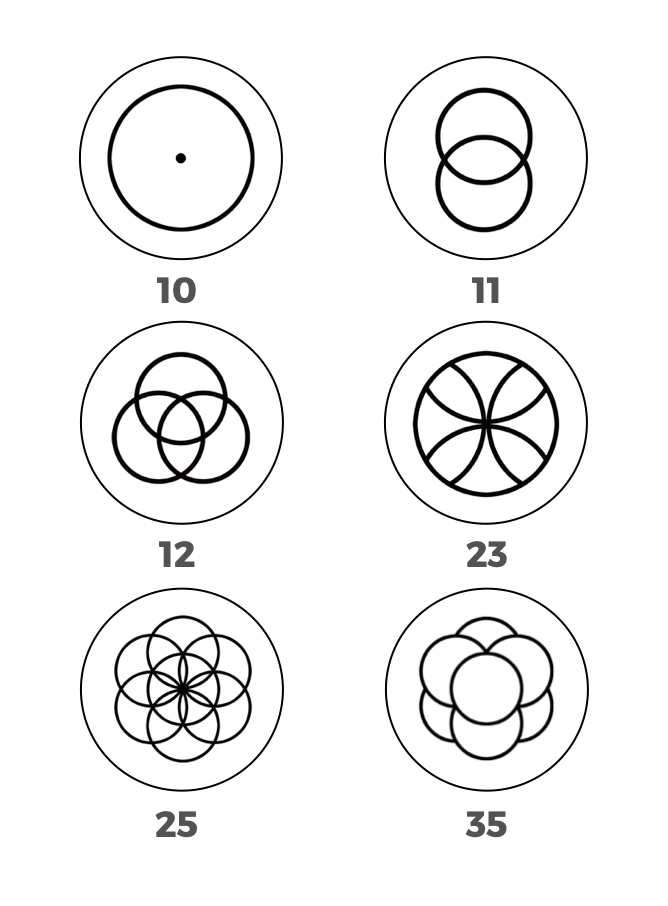
The Flower of Life is the ultimate expression of the creation and interconnection of all things. It represents the primordial pattern from which everything unfolds, linking simple, complex and three-dimensional forms into a perfect, infinite structure.
The Flower of Life is the completeness of creation, the culmination of all geometrical processes. A true matrix of universal life, it contains all the other families, from Crosses to Polygons, Solids to Mixed Symbols. Its mutating energy acts through integration.
In this way, each family of symbols builds logically on the previous one, representing an evolutionary path from idea to complete, interconnected manifestation of the cosmos.
Note that it is not necessary to pass through every stage to reach fulfillment. (Cf. diagram on the Genesis of the 29 symbols). Conversely, the ascending path (from 9 to 1) enables us to reconnect with the Unity of the Source.
Among the 29 symbols, three fundamental energies stand out, illustrating universal dynamics and ways of relating to the world.
Expansion, embodied by certain symbols, evokes extraverted movement, projecting energy outwards to radiate and explore.
Attraction symbolizes introverted movement, gathering forces towards an inner center of gravity, where depth and concentration are reinforced.
Mutation reflects ambiversion, alternating between openness and interiorization, integrating elements to transform harmoniously.
Through their symbols, these three energies reflect a unique alchemy between the individual and the universe.

This energy, directed from the center to the periphery, evokes a movement of diffusion under the effect of the vital breath, an outward thrust.
It manifests itself in the family of crosses (2/20, 4/22, 6/24 and 8/44), where each branch extends energy in all directions.
It builds typical polygons (3/30, 4/40, 5/50, 6/60, 8/80), developing ordered geometric structures.
It acts on simple polygons (6/33, 8/44, 9/90), amplifying their complexity and promoting multidimensional expansion.

This energy acts in the opposite direction, from the periphery to the center. It manifests itself through concentration in the centered polygons (1/10, 7/70, 7/16 and 9/18), refocusing forces to reach essence.
It is achieved in the solid family (4/13, 5/14, 6/15, 8/17 and 8/35), where it strengthens structure and anchoring, making matter denser and more stable at its core.
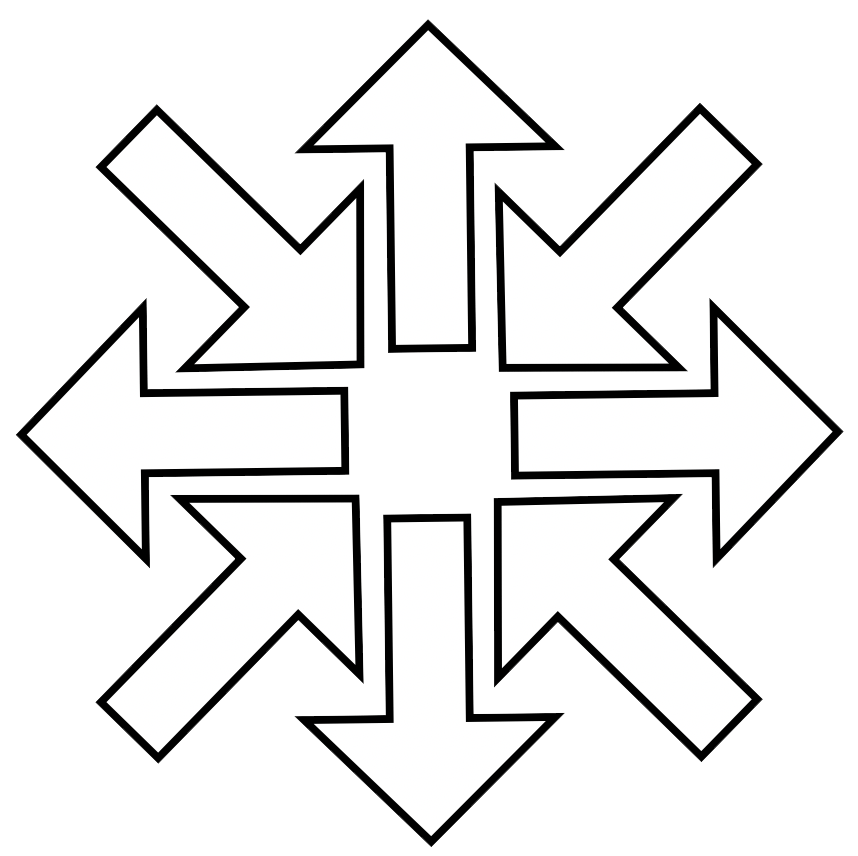
This evolutionary energy works through profound transformation.
It unfolds in the Fleur de Vie (2/11, 3/12, 5/23, 7/25), where each element unites to create harmonious cohesion.
It acts through mixed symbols (7/34, 9/27, 9/36, 9/45), bringing about a fundamental change in nature and form to achieve a new reality in which every aspect is reinvented.
